Critical Coalescence Concentration (CCC) for Surfactants in Aqueous Solutions
Abstract
:1. Introduction
2. Materials and Methods
2.1. Materials
2.2. Methods
3. Results and Discussion
4. Conclusions
Funding
Acknowledgments
Conflicts of Interest
References
- Castro, S.; Miranda, C.; Toledo, P.; Laskowski, J.S. Effect of frothers on bubble coalescence and foaming in electrolyte solutions and seawater. Int. J. Miner. Process. 2013, 124, 8–14. [Google Scholar] [CrossRef]
- Cho, Y.S.; Laskowski, J.S. Effect of flotation frothers on bubble size and foam stability. Int. J. Min. Process. 2002, 64, 69–80. [Google Scholar] [CrossRef]
- Finch, J.A.; Gélinas, S.; Moyo, P. Frother-related research at McGill University. Miner. Eng. 2006, 19, 726–733. [Google Scholar] [CrossRef]
- Finch, J.A.; Nesset, J.E.; Acuna, C. Role of frother in bubble production and behaviour in flotation. Miner. Eng. 2008, 21, 949–957. [Google Scholar] [CrossRef]
- Grau, R.; Laskowski, J.S.; Heiskanen, K. Effect of frothers on bubble size. Int. J. Miner. Process. 2005, 76, 225–233. [Google Scholar] [CrossRef]
- Kracht, W.; Finch, J.A. Bubble break-up and the role of frother and salt. Int. J. Miner. Process. 2009, 92, 153–161. [Google Scholar] [CrossRef]
- Kracht, W.; Finch, J.A. Effect of frother on initial bubble shape and velocity. Int. J. Miner. Process. 2010, 94, 115–120. [Google Scholar] [CrossRef]
- Kracht, W.; Rebolledo, H. Study of the local critical coalescence concentration (l-CCC) of alcohols and salts at bubble formation in two-phase systems. Miner. Eng. 2013, 50–51, 77–82. [Google Scholar] [CrossRef]
- Melo, F.; Laskowski, J.S. Fundamental properties of flotation frothers and their effect on flotation. Miner. Eng. 2006, 19, 766–773. [Google Scholar] [CrossRef]
- Nassif, M.; Finch, J.A.; Waters, K.E. Developing critical coalescence concentration curves for industrial process waters using dilution. Miner. Eng. 2013, 50–51, 64–68. [Google Scholar] [CrossRef]
- Finch, J.; Zhang, W. Frother function-structure relationship: Dependence of CCC95 on HLB and H-ratio. Miner. Eng. 2014, 61, 1–8. [Google Scholar] [CrossRef]
- Schwarz, S.; Alexander, D. Gas dispersion measurements in industrial cells. Miner. Eng. 2006, 19, 554–560. [Google Scholar] [CrossRef]
- Gorian, B.K.; Franzidis, J.P.; Manlaping, E.V. Studies on impeller type, impeller speed and air flow rate in an industrial flotation cell—Part 4 Effect of bubble surface area flux on flotation performance. Miner. Eng. 1997, 10, 367–379. [Google Scholar] [CrossRef]
- Harris, P.J. Chapter 13: Frothing phenomena and frothers. In Principles of Flotation; King, R.P., Ed.; Monograph Series 3; South African Institute of Mining and Metallurgy: Johannesburg, South Africa, 1982. [Google Scholar]
- Kracht, W.; Finch, J.A. Using sound to study bubble coalescence. J. Colloid Interface Sci. 2009, 332, 237–245. [Google Scholar] [CrossRef] [PubMed]
- Pugh, R.J. Foaming, foam films, antifoaming and defoaming. Adv. Colloid Interface Sci. 1996, 64, 67–102. [Google Scholar] [CrossRef]
- Drzymala, J. Mineral. Processing, Foundations of Theory and Practice of Minerallurgy; Oficyna Wydawnicza Politechniki Wroclawskiej: Wroclaw, Poland, 2007. [Google Scholar]
- Cho, Y.S.; Laskowski, J.S. Bubble coalescence and its effect on bubble size and foam stability. Can. J. Chem. Eng. 2002, 80, 299–305. [Google Scholar] [CrossRef]
- Laskowski, J.S. Fundamental properties of flotation frothers. In Proceedings of the 22nd International Mineral Processing Congress, Cape Town, South Africa, 28 September–3 October 2003; Volume 2, pp. 788–797. [Google Scholar]
- Laskowski, J.S.; Tlhone, T.; Williams, P.; Ding, K. Fundamental properties of the polyoxypropylene alkyl ether flotation frothers. Int. J. Miner. Process. 2003, 72, 289–299. [Google Scholar] [CrossRef]
- Zhang, W.; Nesset, J.E.; Rao, R.; Finch, J.A. Characterizing Frothers through Critical Coalescence Concentration (CCC)95-Hydrophile-Lipophile Balance (HLB) Relationship. Minerals 2012, 2, 208–227. [Google Scholar] [CrossRef] [Green Version]
- Gupta, A.K.; Banerjee, P.K.; Mishra, A. Effect of frothers on foamability, foam stability and bubble size. Coal Prep. 2007, 27, 107–125. [Google Scholar] [CrossRef]
- Laskowski, J.S. Testing flotation frothers. Physicochem. Probl. Miner. Process. 2004, 38, 13–22. [Google Scholar]
- Szyszka, D.; Glapiak, E.; Drzymała, J. Entrainment-flotation activity of quartz in the presence of selected frothers. Physicochem. Probl. Miner. Process. 2008, 42, 85–90. [Google Scholar]
- Szyszka, D. Krytyczne stężenie koalescencji potencjalnych spieniaczy do flotacji łupka miedzionośnego, In Lupek Miedzionosny II; Kowalczuk, P.B., Drzymala, J., Eds.; WGGG PWr: Wroclaw, Poland, 2016; pp. 222–227. (In Polish) [Google Scholar]
- Kowalczuk, P.B. Determination of Critical Coalescence Concentration and Bubble Size for Surfactants Used as Flotation Frothers. Ind. Eng. Chem. Res. 2013, 52, 11752–11757. [Google Scholar] [CrossRef]
- Małysa, K.; Czubak-Pawlikowska, J.; Pomianowski, A. Frothing properties of solutions and their influence on the floatability. In Proceedings of the 7th International Congress Surface Actives Substances, Moscow, Russia, 1978; Volume 3, pp. 513–520. [Google Scholar]
- Czarnecki, J.; Małysa, K.; Pomianowski, A. Dynamic frothability index. J. Colloid Interface Sci. 1982, 86, 570–572. [Google Scholar] [CrossRef]
- Moyo, P.; Gomez, C.O.; Finch, J.A. Characterizing frothers using water carrying rate. Can. Matallurgical Q. 2007, 46, 215–220. [Google Scholar] [CrossRef]
- Szyszka, D. Mechaniczna flotacja hydrofilnych ziarn kwarcu w obecności spieniacza. Min. Sci. 2007, 31, 81–88. (In Polish) [Google Scholar]
- Szyszka, D.; Drzymała, J.; Resiak, P.; Mielczarski, E.; Mielczarski, J. Entrainment of quartz in flotation tests with frothers. In Proceedings of the XXIV International Mineral Processing Congress, Beijing, China, 24–28 September 2008; pp. 1068–1073. [Google Scholar]
- Szyszka, D.; Drzymała, J.; Łuczyński, J.; Wilk, K.A.; Patkowski, J. Concentration of α-Terpineol and (2-Dodecanoyloxyethyl)trimethyl ammonium bromide required for prevention of air buble coalescence in aqueous solutions. Physicochem. Probl. Miner. Process. 2006, 40, 53–59. [Google Scholar]
- Szyszka, D. Critical coalescence concetration (CCC) as a parameter for evaluation of selected quaternary ammonium compounds. Min. Sci. 2013, 20, 101–113. [Google Scholar]
- Pacek, A.W.; Man, C.C.; Nienow, A.W. On the Sauter mean diameter and size distributions in turbulent liquid/liquid dispersions in a stirred vessel. Chem. Eng. Sci. 1998, 53, 2005–2011. [Google Scholar] [CrossRef]
- Grau, R.A. An Investigation of the Effect of Physical and Chemical Variables on Bubble Generation and Coalescence in Laboratory Scale Flotation; Helsinki University of Technology Doctoral Theses in Materials and Earth Sciences, 4; Laboratory of Mechanical Process Technology and Recycling: Espoo, Finland, 2006. [Google Scholar]
- Grau, R.; Heiskanen, K. Gas dispersion measurements in a flotation cell. Miner. Eng. 2003, 16, 1081–1089. [Google Scholar] [CrossRef]
- Quinn, J.J.; Kracht, W.; Gomez, C.O.; Gagnon, C.; Finch, J.A. Comparing the effect of salts and frother (MIBC) on gas dispersion and froth properties. Miner. Eng. 2007, 20, 1296–1302. [Google Scholar] [CrossRef]
- Quinn, J.J.; Sovechles, J.M.; Finch, J.A.; Waters, K.E. Critical coalescence concentration of inorganic salt solutions. Miner. Eng. 2014, 58, 1–6. [Google Scholar] [CrossRef]
- Drzymala, J.; Kowalczuk, P.B. Classification of Flotation Frothers. Minerals 2018, 8, 53. [Google Scholar] [CrossRef]
- Sobczyk, M. Statistics Practical and Theoretical Aspects; Publisher UMTS: Lublin, Poland, 2006. [Google Scholar]
- Malysa, E.; Malysa, K.; Czarnecki, J. A Method of comparison of the frothing and collecting properties of frother. Colloids Surf. 1987, 23, 29–39. [Google Scholar] [CrossRef]
- Gupta, A.K.; Banerjee, P.K.; Mishra, A.; Satish, P.; Pradip. Frother Characterization with Two-Phase Foam System. In Proceedings of the International Seminar on Mineral Processing Technology and Indo-Korean Workshop on Resource Recycling (MPT-2006), NML, Chennai, India, 8–10 March 2006. [Google Scholar]
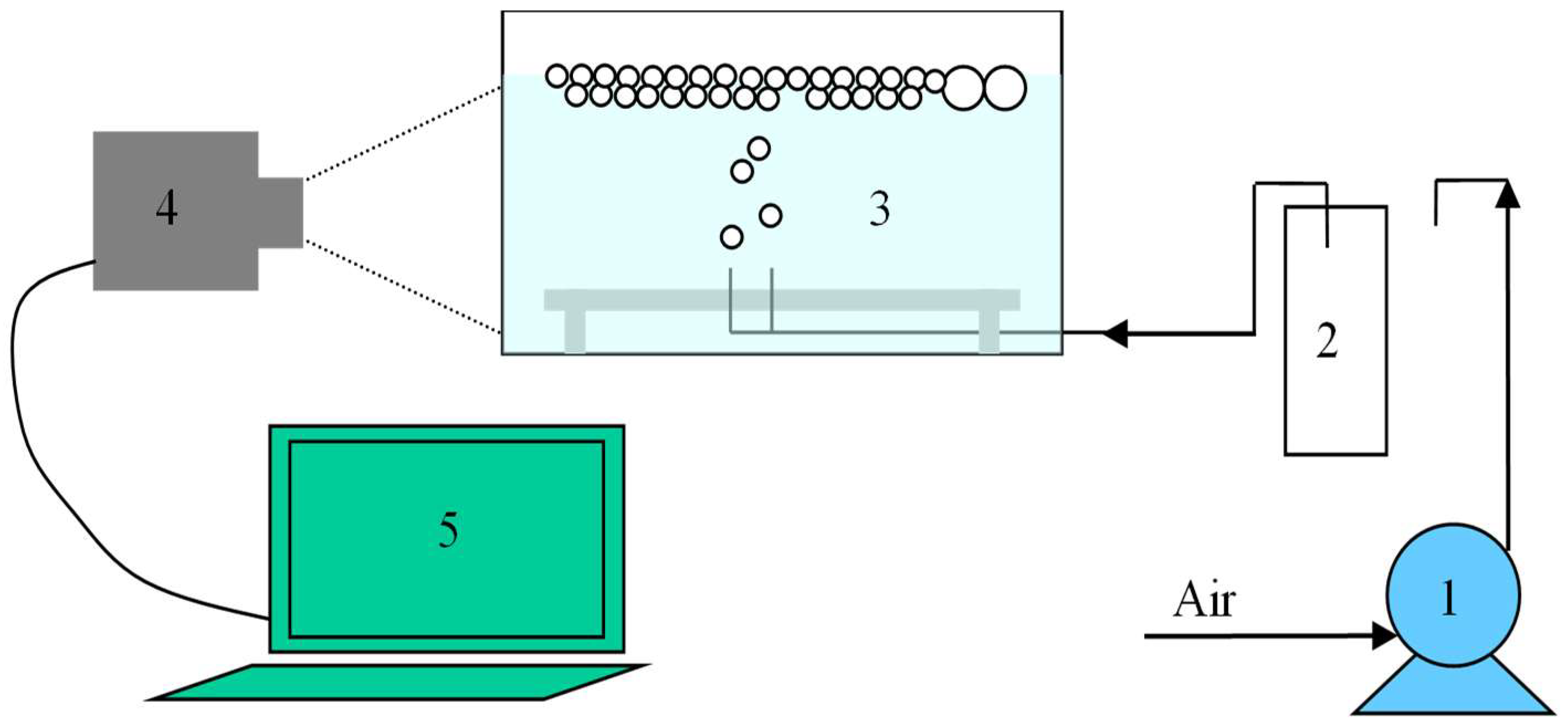
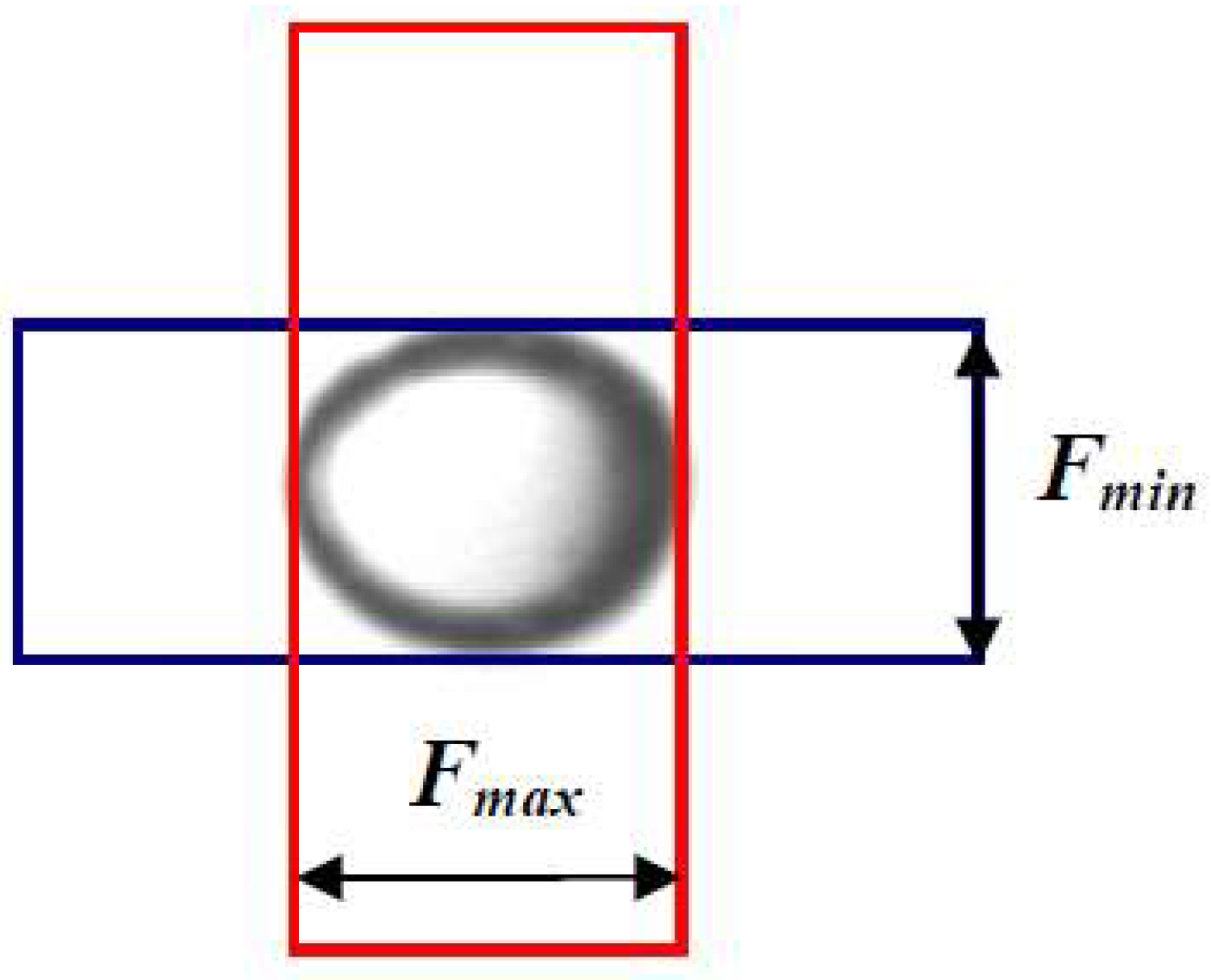
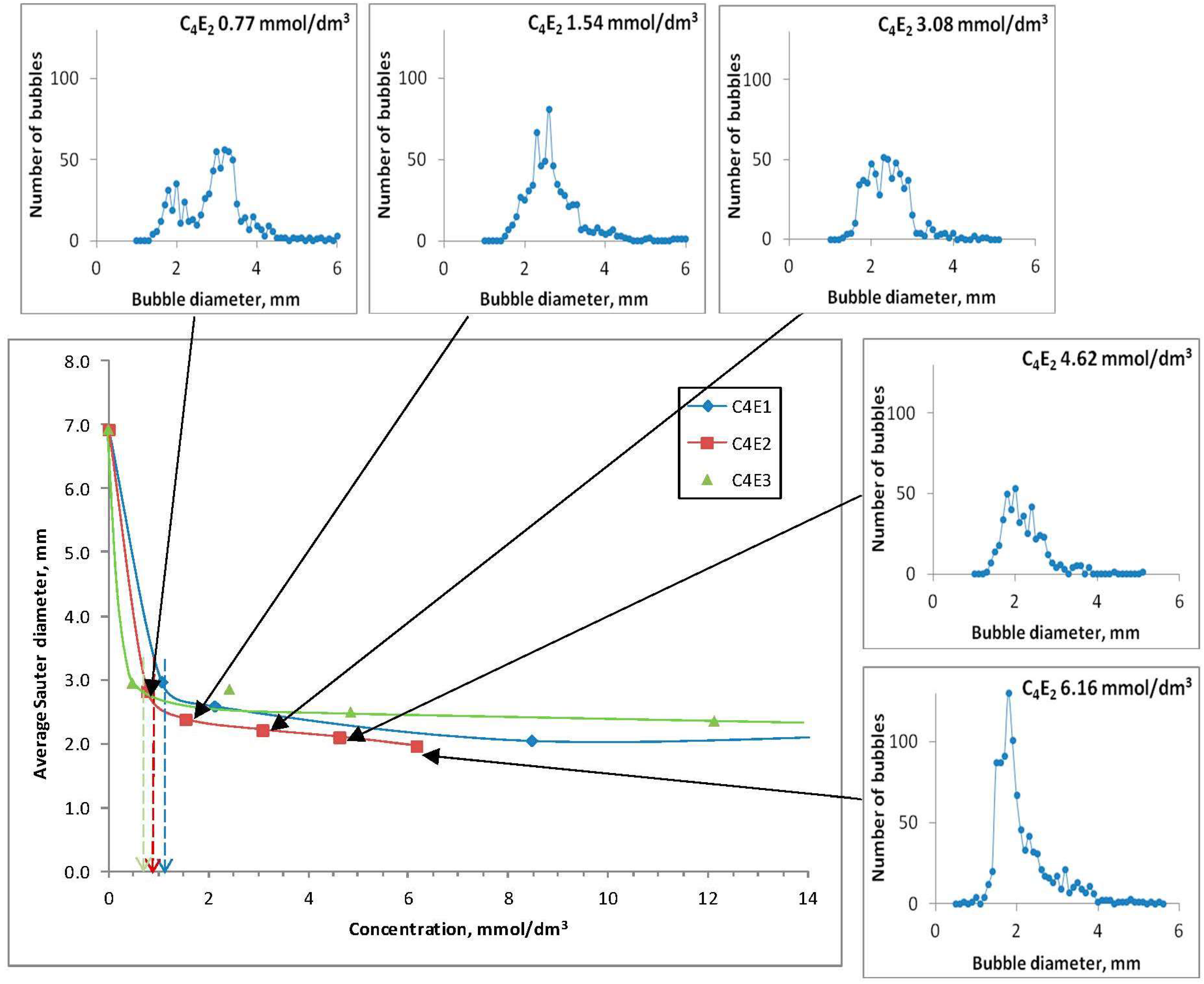
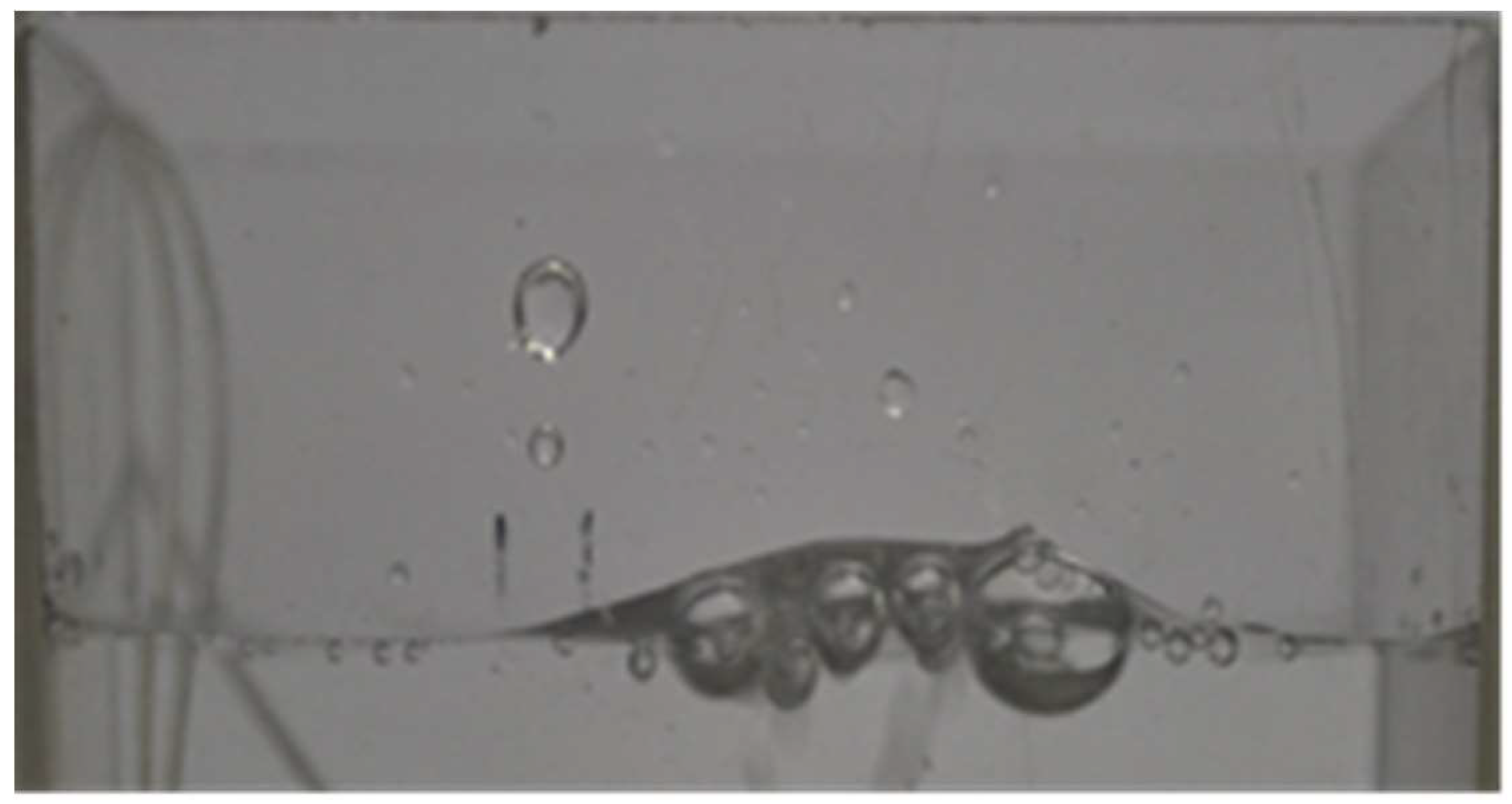
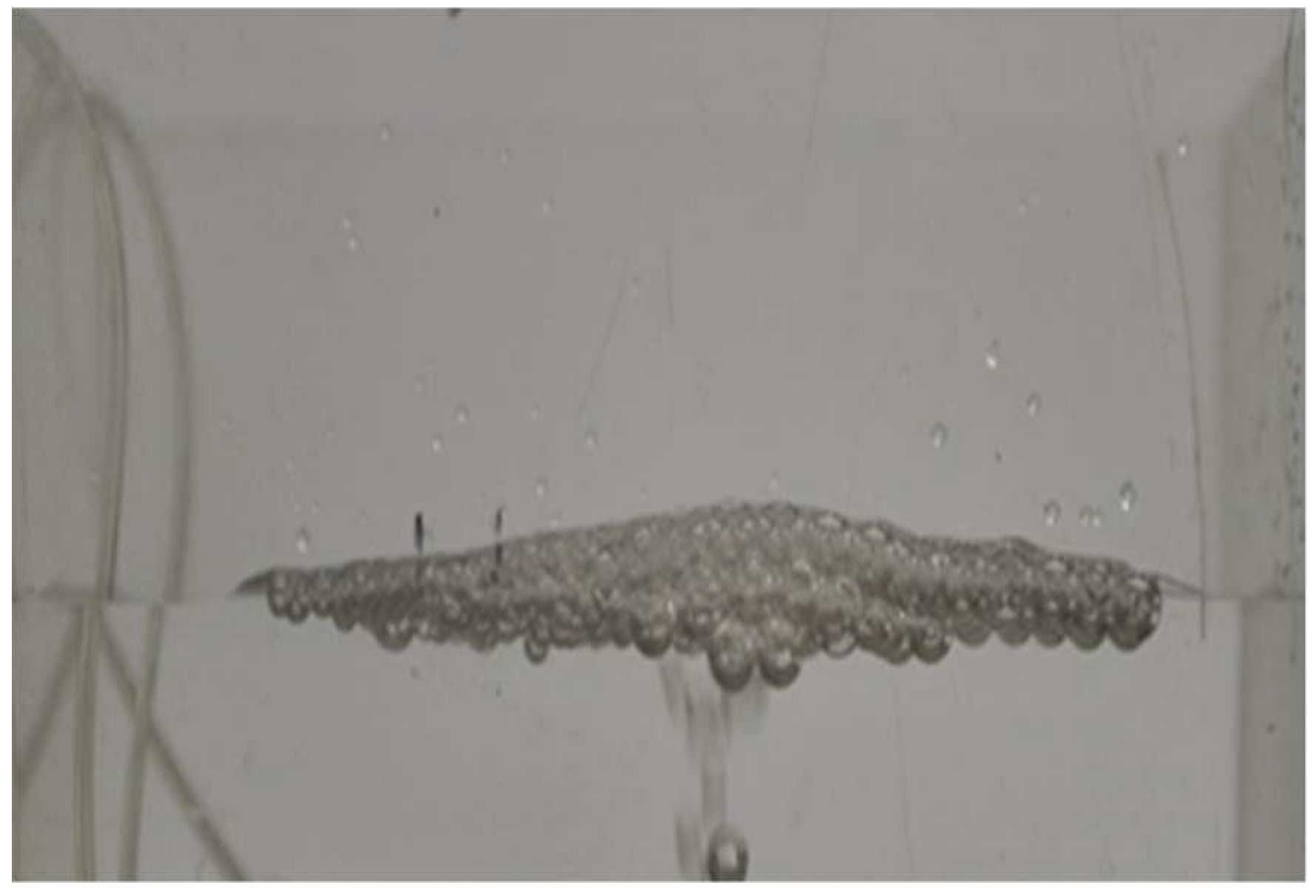
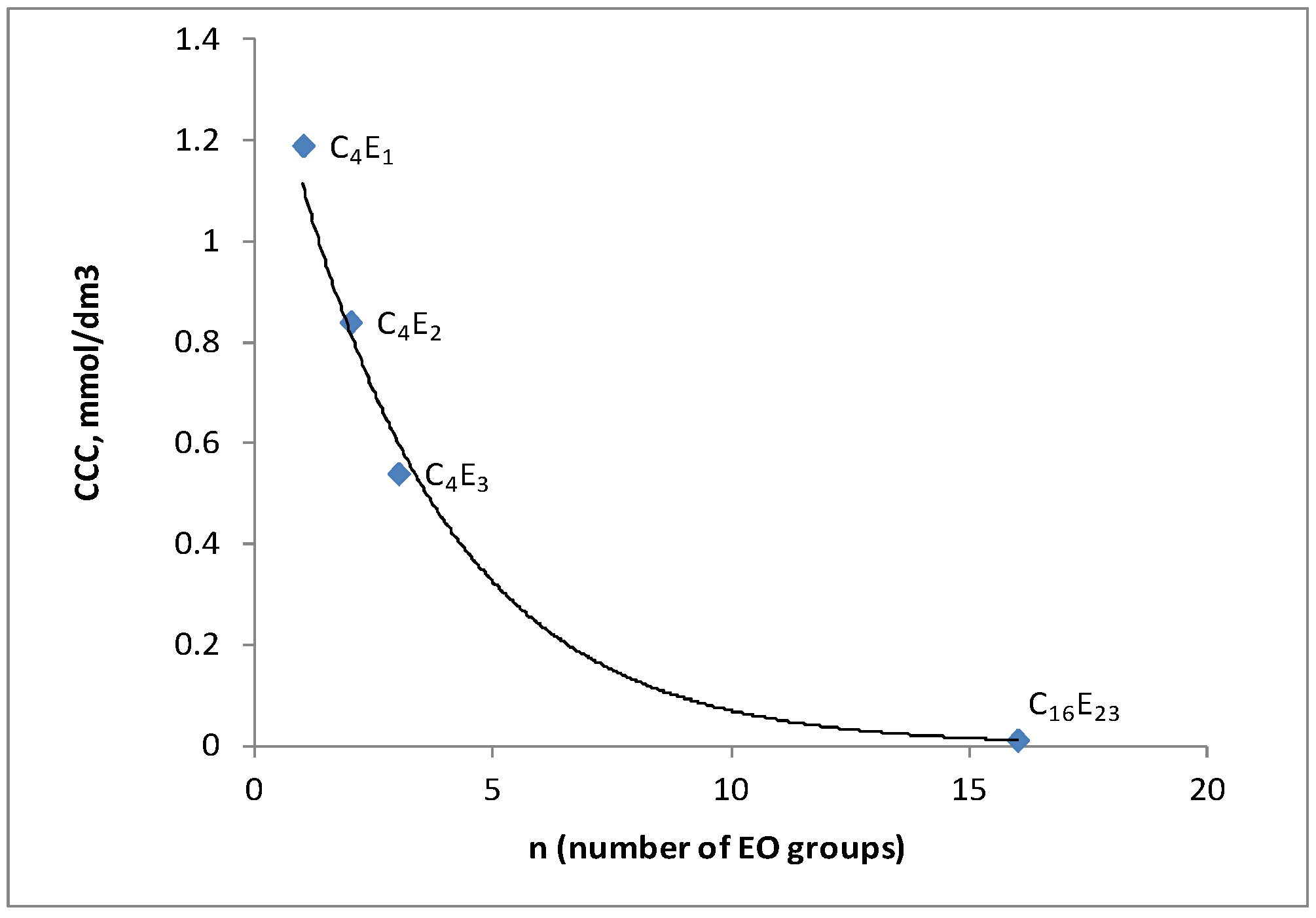
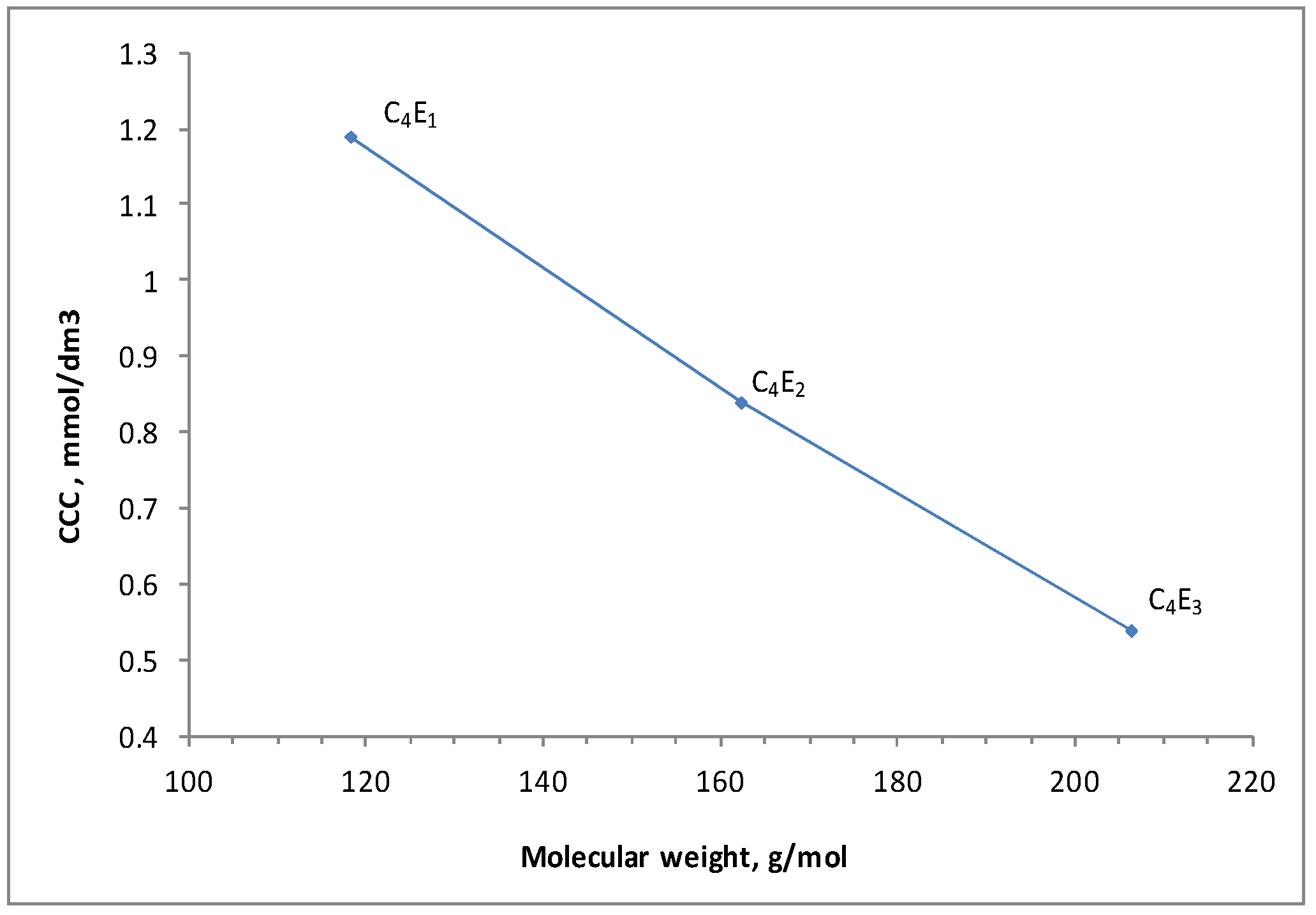
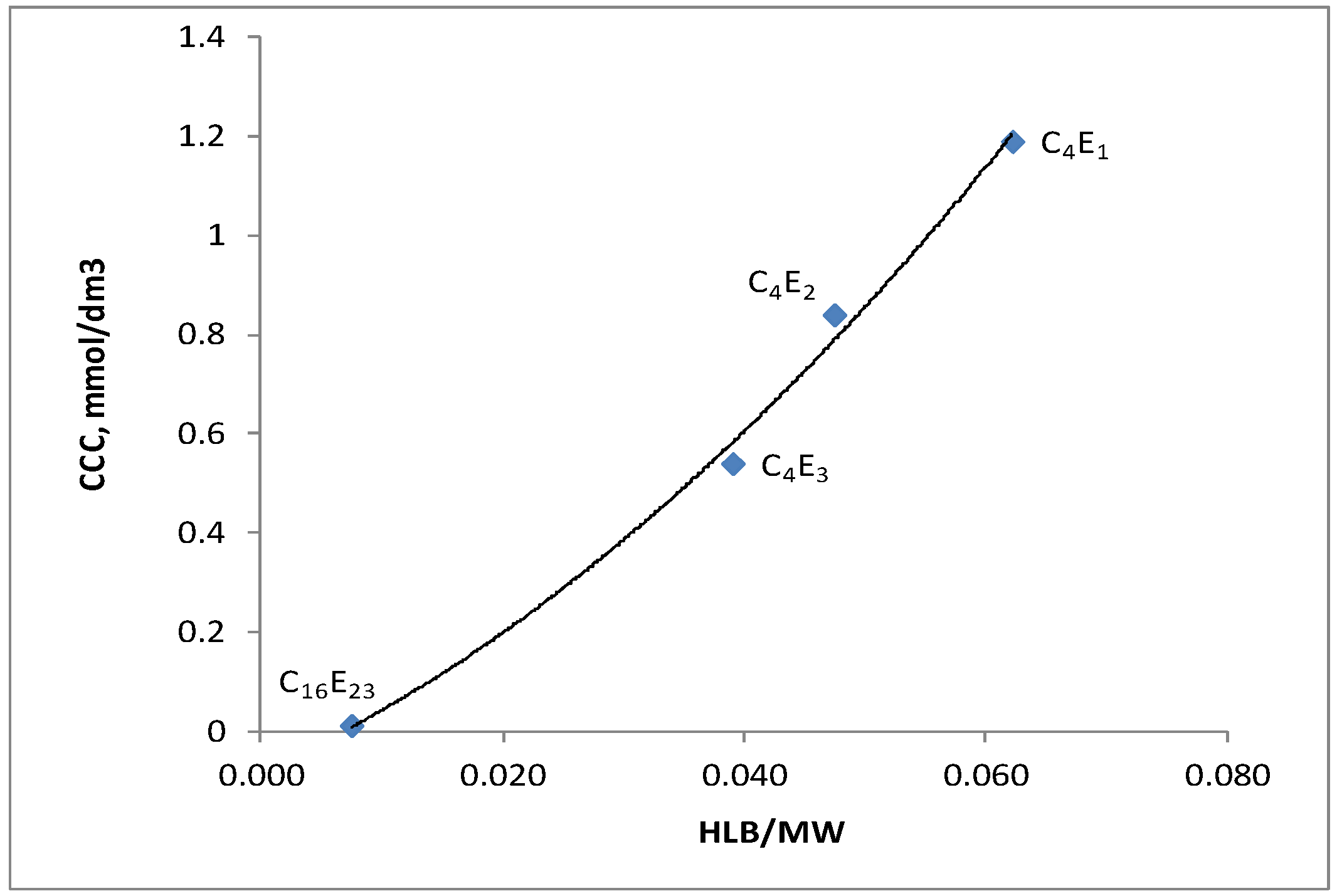
| Reagent | Purity (%) | Concentration (mmol/dm3) | |
|---|---|---|---|
| Ethylene glycol butyl ether (C4E1) | 100 | 1.06 | 8.46 |
| 1.27 | 16.92 | ||
| 2.12 | |||
| Diethylene glycol butyl ether (C4E2) | ≥99 | 0.77 | 4.62 |
| 1.54 | 6.16 | ||
| 3.08 | |||
| Triethylene glycol butyl ether (C4E3) | ~70 | 0.48 | 12.12 |
| 2.42 | 24.24 | ||
| 4.85 | |||
| Properties | Ethylene Glycol Butyl Ether | Diethylene Glycol Butyl Ether | Triethylene Glycol Butyl Ether |
|---|---|---|---|
| Structural formula |  |  |  |
| Formula | CH3(CH2)3(OC2H4)OH | CH3(CH2)3OC2H4OC2H4OH | CH3(CH2)3(OC2H4)3OH |
| Molecular formula | C6H14O2 (C4E1) | C8H18O3 (C4E2) | C10H22O4 (C4E3) |
| Family | Polyglycols | Polyglycols | Polyglycols |
| Purity | 100% | ≥99% | ~70% |
| Density | 0.990 g/mL at 25 °C | 0.953 g/mL at 20 °C | 0.990 g/mL at 20 °C |
| Molecular weight (g/mol) | 118.17 | 162.23 | 206.28 |
| Number CAS | 9004-77-7 | 112-34-5 | 143-22-6 |
| Producer | Sigma-Aldrich | Fluka Analytical | Sigma-Aldrich |
| Frother | CCC (mmol/dm3) | CCC (ppm) |
|---|---|---|
| Ethylene glycol butyl ether (C4E1) | 1.19 | 140.62 |
| Diethylene glycol butyl ether (C4E2) | 0.84 | 136.27 |
| Triethylene glycol butyl ether (C4E3) | 0.54 | 105.20 |
© 2018 by the author. Licensee MDPI, Basel, Switzerland. This article is an open access article distributed under the terms and conditions of the Creative Commons Attribution (CC BY) license (http://creativecommons.org/licenses/by/4.0/).
Share and Cite
Szyszka, D. Critical Coalescence Concentration (CCC) for Surfactants in Aqueous Solutions. Minerals 2018, 8, 431. https://doi.org/10.3390/min8100431
Szyszka D. Critical Coalescence Concentration (CCC) for Surfactants in Aqueous Solutions. Minerals. 2018; 8(10):431. https://doi.org/10.3390/min8100431
Chicago/Turabian StyleSzyszka, Danuta. 2018. "Critical Coalescence Concentration (CCC) for Surfactants in Aqueous Solutions" Minerals 8, no. 10: 431. https://doi.org/10.3390/min8100431
APA StyleSzyszka, D. (2018). Critical Coalescence Concentration (CCC) for Surfactants in Aqueous Solutions. Minerals, 8(10), 431. https://doi.org/10.3390/min8100431





